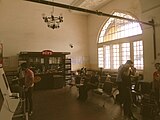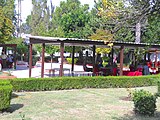Adana railway station
ADANA | |||||||||||||||||||||||||||||||||
|---|---|---|---|---|---|---|---|---|---|---|---|---|---|---|---|---|---|---|---|---|---|---|---|---|---|---|---|---|---|---|---|---|---|
| TCDD intercity and regional rail station | |||||||||||||||||||||||||||||||||
 Main building | |||||||||||||||||||||||||||||||||
| General information | |||||||||||||||||||||||||||||||||
| Location | Uğur Mumcu Meydanı, Kurtuluş Mah., Seyhan/Adana 01130 Turkey | ||||||||||||||||||||||||||||||||
| Coordinates | 37°00′13″N 35°19′09″E / 37.00361°N 35.31917°E | ||||||||||||||||||||||||||||||||
| Owned by | Turkish State Railways | ||||||||||||||||||||||||||||||||
| Operated by | TCDD Taşımacılık | ||||||||||||||||||||||||||||||||
| Line(s) | |||||||||||||||||||||||||||||||||
| Platforms | 2 (1 island platform, 1 side platform) | ||||||||||||||||||||||||||||||||
| Tracks | 3 | ||||||||||||||||||||||||||||||||
| Construction | |||||||||||||||||||||||||||||||||
| Structure type | At-grade | ||||||||||||||||||||||||||||||||
| Parking | Yes | ||||||||||||||||||||||||||||||||
| Architectural style | Turkish Neoclassical | ||||||||||||||||||||||||||||||||
| Other information | |||||||||||||||||||||||||||||||||
| Station code | 6503 | ||||||||||||||||||||||||||||||||
| History | |||||||||||||||||||||||||||||||||
| Opened | September 1912 | ||||||||||||||||||||||||||||||||
| Services | |||||||||||||||||||||||||||||||||
| |||||||||||||||||||||||||||||||||
| |||||||||||||||||||||||||||||||||
Adana station (Turkish: Adana garı) is a railway station in Adana and one of the major railway hubs in Turkey. The station is located at the İstasyon Square, in Kurtuluş, Seyhan.
The Central Station is steps away from the Vilayet Metro station and the Adana Province Hall. It surrounds the İstasyon Square together with the Central Post Office, Türk Telekom and TCDD Regional Headquarters.
History
[edit]


The first railway station in Adana was built in 1886 in the Kuruköprü area along the 67 km (42 mi) railway line that connected Adana to Mersin. In 1903, the Ottoman Government contracted Istanbul-Baghdad section of the Berlin-Baghdad Railway project to Germany. In 1911, the Yenice-Adana section of the Mersin-Adana railway line was merged with the Berlin-Baghdad railway project. The status of the Adana railway station was raised to a major station with the expected increase in volume. A larger station building and maintenance shops were needed to be built, but the existing train station was not suitable for expansion. So the train station in the Kuruköprü area was abandoned and the construction of a new train station was started in 1911 on farmland north of the city. The construction of the new railway station was completed in September 1912,[1] covering an area of 45 hectares. It contained a station building, staff residences, maintenance shops and a foundry.[2]
Architecture
[edit]







The station building is built in the First National Architectural Style. It is a 3-storey structure with wide eaves and a triangular roof and has a U-plan in which the open area faces the square. The middle section, which connects to the square through three sharp arch gates, is the main hall with a high ceiling and includes the waiting room, ticket offices and the information desk. The middle section also splits into three areas. The two areas on the right side of the middle section comprise two floors. Above the area on the left side, there is a cafe which is entered from Platform I. Below the cafe, there are the ticket offices and the check room. There are administrative offices at the north part of the east and the west wing of the building, facing platform I. The offices at the west wing are designated for the station manager and the assistant, and the ones on the east wing are designated for security and other services. On the upper floor, there are six residences of different sizes. The residences on the wings are larger than the residences above the main hall. The residences above the main hall are accessed from the stairs at the wings.
The main hall, which is two floors high is spacious. The four-piece window sets, facing Platform I at the upper section of the north walls, provide plenty of light to the hall. The bands that are covered with geometric forms, stretching in east-west direction on the ceiling, also add quality to the space. The light shining from the roof to the stairwells on both wings is a unique feature. The eaves surrounding the roof on the upper portion of the wings and the twin window sets beneath, the wide eaves extending all along above the arch gates at the middle section of the elegantly designed building front show that horizontal elements are dominant in the architecture. The ground and the first floor windows in front of the wings are in vertical frame, forming a more stable image. The elements that surround the windows have a perpendicular effect and finish with 3-slice twin blind arches which further increases perpendicularity. Thin mouldings beneath the twin window sets of the second floor which wrap around the entire building, and hewn stones which overflow from the surface at the corners and the wood supports of the wide eaves, are elements that build the architectural identity of the building's frontage.
The north side of the building facing platform I is two-storey. Eaves and the upper floor windows are identical to the front side. Also like the front side, three-slice twin blind arches are placed above the doors and the windows of the offices that are at the same level with platform I. The other features of this side is the two four-piece windows that provide view to the main lobby downstairs. Wide eaves that are added to this side after prevents it to be perceived as a whole. The west and the east sides of the building are designed with a simpler perception than the front side. The features that are formed with slice arches are not used at these sides. Ornaments of the building are the two large rectangular-shaped faience panels on both sides of the main entrance, the faiences that placed in a niche at the section of the west and east wings that face the main entrance and the geometric shaped ornaments at the bottom surface of the eaves.
Station layout
[edit]Adana Central railway station has two platforms and four tracks. Track I and Track II are reserved for Adana-Mersin Regional trains. Track III is for the rest of the passenger lines that stop at the station. Track IV has no platform, therefore serves freight trains that cross the station without stopping. Platforms are connected to the Station Hall through an underground walkway. Both platforms are wheelchair accessible with designated escalators. Lockers for daily luggage storage, are located at the walkway.
Passenger platforms can only be accessed through the Main Station Building, either from inside, or through the sides of the building. Vilayet Metro Station is accessed by walking from the Main Building towards west, on the street parallel to the station. There is no passenger entrance north of the tracks, from the Mustafa Kemalpaşa Boulevard to the station.

Bicycles and car parking
[edit]Bicycles are not permitted at any of the Passenger Line that stop at the station as a TCDD policy,[3] though the train conductors let bicycles into the Main Line (long distance) and to the Regional trains, if the trains are not full. Bicycles are not permitted to the high-speed trains of the Adana-Mersin Line at all. Bicycle parking is located at the east wing of the Main Hall.
There is a paid car parking in front of the Main Station at the İstasyon Square.
Service
[edit]| Final Destination | Type / Line | Previous St. | Next St. | Frequency |
|---|---|---|---|---|
| Regional / Adana-Mersin | Terminus |
27 services daily | ||
| Regional / Iskenderun-Mersin | daily at 19:00 | |||
| Regional / İslahiye-Mersin | daily at 18:35 | |||
| Mainline / Toros Ekspresi | Terminus | daily at 07:45 | ||
| Mainline / Çukurova Ekspresi | daily at 19:30 | |||
| Mainline / Fırat Ekspresi | daily at 07:40 | |||
| Mainline / Erciyes Ekspresi | suspended until 31.12.2016[4] | |||
| Mainline / İç Anadolu Mavi Treni | suspended until further notice[4] |
Buses
[edit]Central station is accessed by Municipality Buses. Bus #174 is an hour-interval service that connects the station to the Central Coach Terminal, Yüreğir Coach Terminal and to the D400 state road.[5][6] Bus #111 is a 40-minute interval service that connects the station to the old town and the Taşköprü area.[7][8] Both buses stop in front of the main building.
Bus #159 is a 35-minute interval service that connects the station to the Şakirpaşa airport and the old town.[9] The bus stop is at the Vilayet Metro Station, west of the Central Station's main building.
Images
[edit]-
Passenger Hall at the Main Building
-
Office Buildings at Adana Gar
-
Child care at Adana Gar
-
TCDD Çukurova Regional Headquarters at the İstasyon Square
-
TCDD Lounge
-
Staff apartments
-
TCDD Inn
References
[edit]- ^ "Adana Garı". Food & Travel Magazine (in Turkish). Archived from the original on 15 June 2010.
- ^ "History of the architecture of the stations" (PDF) (in Turkish). Edebiyat Dergisi. Archived from the original (PDF) on 22 July 2011.
- ^ "TCDD Bicycle Policy" (in Turkish). TCDD. Archived from the original on 1 October 2015. Retrieved 29 September 2015.
- ^ a b "ANAHAT TRENLERİ". TCDD. Archived from the original on 5 November 2016.
- ^ "174 MERKEZ OTOGAR - MOBİLYACILAR SİT. Otobüs Saatleri - Adana Büyükşehir Belediyesi". Archived from the original on 5 October 2015. Retrieved 5 October 2015.
- ^ "174 MERKEZ OTOGAR - MOBİLYACILAR SİT. Otobüs Güzergah ve Durakları - Adana Büyükşehir Belediyesi". Archived from the original on 5 October 2015. Retrieved 5 October 2015.
- ^ "111 DSİ TOKİ - E.VİLAYET Otobüs Güzergah ve Durakları - Adana Büyükşehir Belediyesi". Archived from the original on 5 October 2015. Retrieved 5 October 2015.
- ^ "111 DSİ TOKİ - E.VİLAYET Otobüs Saatleri - Adana Büyükşehir Belediyesi". Archived from the original on 6 October 2015. Retrieved 5 October 2015.
- ^ "159 S.UYGULAMA HAS. - HAVALİMANI Otobüs Güzergah ve Durakları - Adana Büyükşehir Belediyesi". Archived from the original on 1 October 2015. Retrieved 5 October 2015.







